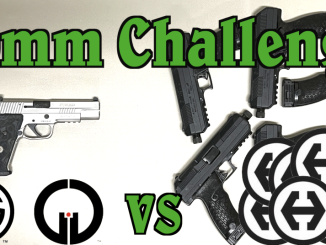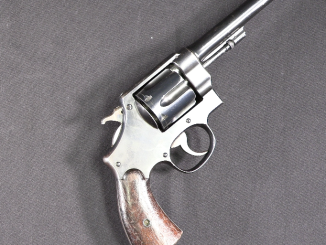The Moore patent “teatfire” revolver was one of the more (no pun intended) successful workarounds to the Rollin White patent. Designed by Daniel Moore and David Williamson, the gun was a 6-shot .32 caliber pocket revolver which used a proprietary type of cartridge. It was loaded from the front, and the rear of the case had a nipple in its center full of priming compound. This allowed the rear of the cylinder to only have a small hole through which the hammer could reach to hit the nipple and fire the round, as opposed to a rimfire design in which the whole rear of the cartridge had to be exposed at the back of the cylinder. Some examples, including this one, included a unique type of extractor for pushing out spent cases.
Related Articles

Commentary
Recent Developments in Auto-Loaders (1922)
Today’s guest author is none other than Julian Hatcher – although he didn’t give me permission to use his article on account of having passed away 20 years before I was born. I was looking […]

Semiauto pistol
Project Best Millimeter: SIG/Grayguns vs Hi-Point 10mm
Thanks to Otis Technology for sponsoring this video! When I heard about Hi-Point releasing a 10mm pistol (the JXP 10), I knew I needed to do something fun with it. Hi-Point is often derided – […]

Revolver
S&W M1917: A US Army revolver in .45 ACP
When the United States entered World War One, it had a significant shortfall in military handguns. The M1911 pistol production was expanded as much as possible, but more guns were needed. Both Colt and Smith […]

This system reminds me Soviet Rikhter R-23 auto-cannon, cartridge are also loaded to cylinder from front, however they are center-fire electric-primer.
https://en.wikipedia.org/wiki/Rikhter_R-23
It was only used in Tupolev Tu-22 bombers (tail gunner), however in practice the gun and mount proved be unreliable and has low accuracy, so it was not used in any other aircraft.
You can see photo of cartridge for R-23 here:
http://www.russianammo.org/Russian_Ammunition_Page_25mm.html
The R-23 is also the first and only real “space gun”, on board the secret Almaz 2 (cover civilian designation: Salyut 3) military space station in 1974. Why the Soviets felt that the space station (military or not) had to be armed is a little difficult to understand.
Suppose America were to target a Soviet satellite and then attack it with a big missile. What would the cosmonauts do to avoid being blown to bits?
Cannon* was fixed (aft-mount) to Salyut 3, so only way to aim it was to revolve whole station. Russian wikipedia in Салют-3 article states that:
“У руководителей советского военно-промышленного комплекса появились опасения, а вдруг американцы на своём крылатом «челноке» подлетят к советскому искусственному спутнику и украдут его.”
which mean: Soviet War-Industry Directorate fear that Americans will use their space shuttle to steal soviet space station.
* – exact model is unclear, some sources states Rikhter R-23, some just “Nudelman cannon”, above cited Салют-3 article states special-made «Щит-1» developed from NS-23 (Nudelman Suranov) cannon
BTW: Whatever cannon was mounted to Салют-3 it was not only “space gun” designed in Soviet Union.
Laser pistol and laser revolver was designed
https://ru.wikipedia.org/wiki/Лазерный_пистолет
It was non-lethal weapon designed to blind enemy cosmonauts and damaging sensitive optical sensors. As it doesn’t have recoil it may in place without gravity and also because it will not penetrate space vehicle walls it may be used inside it.
TP-82 break-action survival fire-arm were hold inside Soyuz spacecrafts. Has 2 40-gauge barrel and one 5.45mm.
If you wonder how Soviet Laser pistol works:
Each cartridge contain Zirconium foil, oxygen and metal salts. It is ignited electrically with Tungsten-Rhenium wire, when it is ignited it is similar to magnesium flash used in early photography. It burn by 5-10ms giving temperature 5000K. Metal salts are used to get required spectrum.
“Barrel” is a optical fiber, “muzzle” energy is 1-10J, effective range 20m.
Daweo;
Technically, it would be defined as a chemical-cartridge laser, with each “cartridge” acting as a one-shot capacitor to generate the energy for one shot.
Interestingly enough, this type of laser weapon was predicted in the Traveller science fiction role-playing game over thirty years ago. See the Reformation Coalition Equipment Guide from 1994 for their best explanation of how it works;
http://www.amazon.com/Reformation-Coalition-Equipment-Traveller-Roleplaying/dp/1558781668
cheers
eon
The stealing explanation does make some sense, because such a cannon would have been useless against missiles traveling at orbital velocities.
Just a quick comment from someone who grew up with cow poop on his boots… the proper pronunciation of “teat” is “tit” – the “a” is silent. We were a beef family but my best friend’s family was dairy and I always got a kick out of my buddy’s very proper and religious mom using what I thought was a bad word to describe the part of the cow the milk came out of. But she spelled it “teat” of course.
@jim in houston: “the proper pronunciation of ‘teat’ is ‘tit’” – That may be true in the local you were from, but everywhere else that I’ve heard of pronounces it as “teat” with a long “e”. I think you’ll find yourself “sucking the hind teat” on this argument.
You may be right – we talk funny where I come from. (West of Jefferson City the state is called “Missour-ah” – only people from around St. Louis call it Missour-ee.”) My favorite from the quaint patois of my native feedlots was a buddy-since-diapers whose family was big on the word “hermantile” – as in “Lightnin’ stuck the cottonwood and them cows went completely hermantile.” Later I ran into it in a novel by Clair Huffaker, in pretty much the same context, and then it showed up again a few times in the Navy novels of P. T. Deuterman. So I sent Captain Deuterman an email asking him where he got the word and if he had any idea what it meant. He replied that he had gotten it from a guy from Montana he had served under as a junior officer who meant that if things didn’t get organized he was going to go ballistic, only he called it hermantile. As luck would have it I ran into a linguistic anthropologist I met in an internet group and after a few days of study she reported that “hermine” (with a silent “h”) is French for “winter weasel” and weasels are noted for going even crazier than most animals when caught in a leghold trap. Since every use of the word I had found was from somewhere in the Missouri River Valley she theorized that it was a pre-Louisiana Purchase phrase used by French fur traders to mean “crazy as a trapped weasel” and it was adopted by Anglo cowboys (who decided to pronounce the “h”) as they moved west. It’s a great word. I told a group of grade-schoolers at our community garden a while back that if they didn’t start behaving I was fixin’ to go hermantile on them and everyone got very quiet and wide-eyed.
Both words meant originally the same thing, of course, and possibly also have the same origin, but “teat” was borrowed later from Old French, whereas “tit” was “titt” in Old English. Technically speaking “tit” still has the same “polite” meaning as “teat”, although “tit” is usually avoided in most texts for obvious reasons. The vulgar meaning, “a woman’s breast”, is later, although fairly old as well.
I think MG has it right about the proper pronunciation.
With respect to that lever operated ejector, I have to wonder if it was a safety hazard if you had a stuck but unfired cartridge. It pushed directly on the primer teat, and it may have had the potential to set off an unfired cartridge.
Overall though, I can’t see any obvious major disadvantages to a teat-fire cartridge versus a rim-fire cartridge for that era, other than the cartridge being less common. I’m not surprised therefore that this revolver was relatively successful.
I think one would have to remember to point the gun away from people and at something that won’t die when shot (like mud puddles).
With this design one would not have to worry about a ruptured case head. That was an issue with early “ballon head” cases.